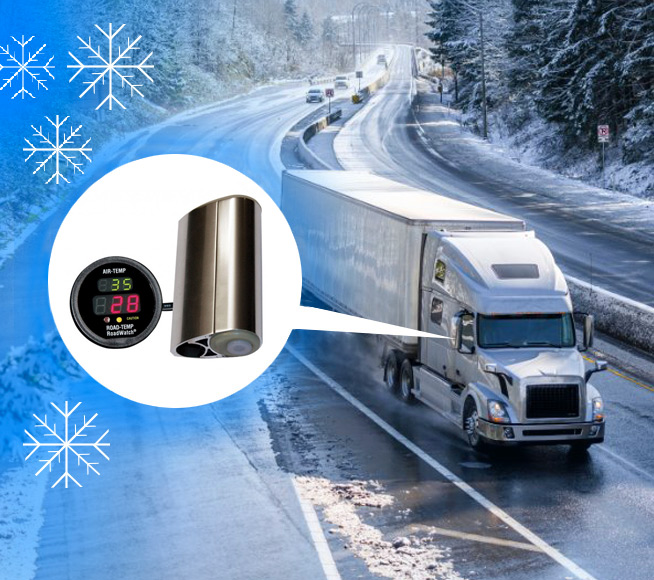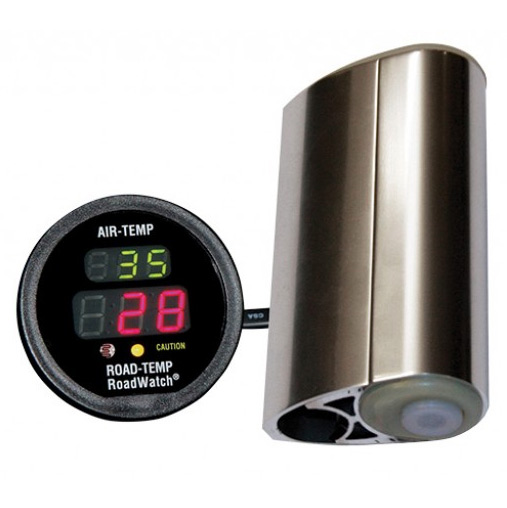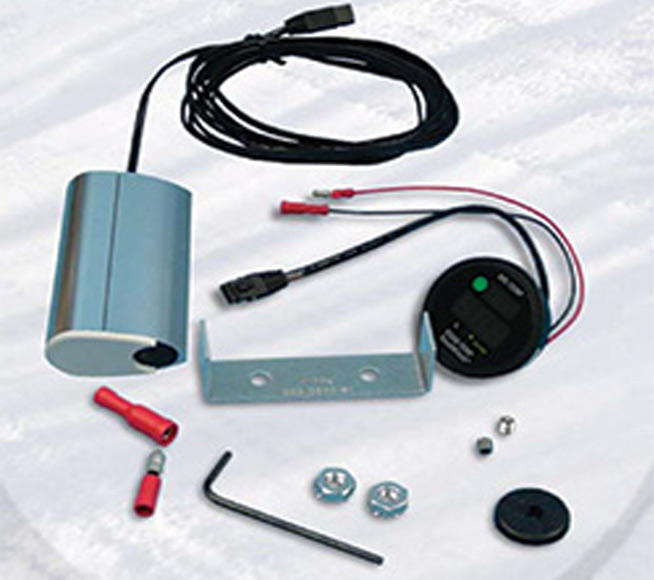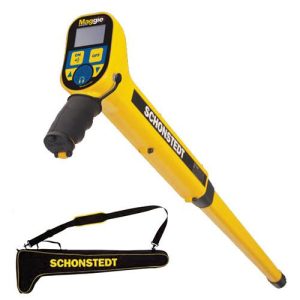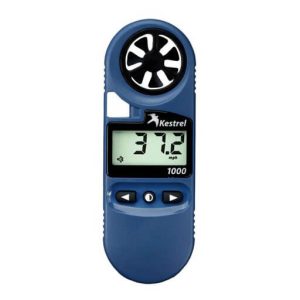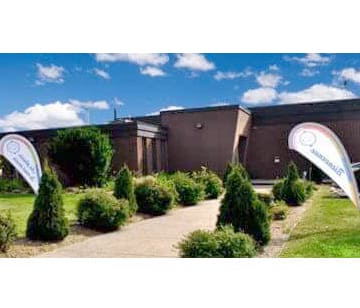RoadWatch SS is the result of a continual improvement effort designed to incorporate significant changes to enhance the performance of our product.
The changes you’ll find described below are the result of extensive product testing, research, and feedback from users. We firmly believe that the end result of these efforts is a safety system that is simply the best in the industry. Your input is invaluable and most appreciated as we proudly offer you an even safer driving solution.
Easy, Quick Sensor Head Replacement
Outside your truck, a harsh environment is waiting. Sensor heads can be damaged and the last thing you need is extensive repair time. Now, in five minutes, the sensor head can be replaced outside the vehicle without rerouting the cable.
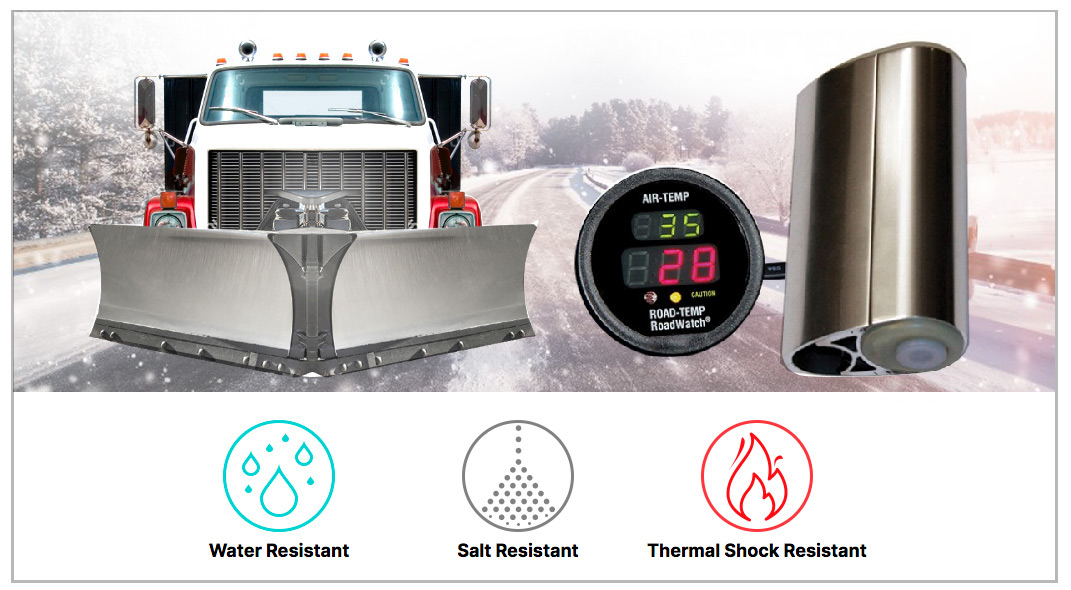
Improved Air Sensor
We know that the sooner you’re aware of the potential danger the better. RoadWatch SS responds much more quickly to temperature changes than our previous version.
Extension Cables
Now you can extend out to beyond the standard cabling length with extensions of 4, 12, and 16 feet and take the overall length to 60 usable feet.
Flexible Cabling
A modest improvement but something greatly appreciated when you’re routing into tight spaces under the dash or through the door. RoadWatch Kit Sensor Head Extension Cable Temperature Gauge
RoadWatch Kit
RoadWatch SS features the most technologically advanced early warning system for road and air temperatures in the industry.
Our new state-of-the-art system continuously monitors and displays air and road temperatures to a digital monitor mounted on the instrument panel. RoadWatch SS is designed to give drivers advance notice of potential road freezing before a problem arises. In addition to an improved sensor, the new RoadWatch SS is easier to install or replace than our previous version. Your most important assets are your people… they deserve the best protection available… they deserve RoadWatch SS
How does it work?
RoadWatch is a device that is able to measure the temperature of a surface by measuring the heat that is radiated by any object warmer than −459.67° Fahrenheit (referred to as absolute zero). This means everything that we encounter in the real world is radiating heat. The easiest way of thinking about this is to look at a standard incandescent light bulb that is turned on. We can see the light from the light bulb as well as feel the heat being radiated from it when we hold our hand near the bulb. The heat that we feel is known as infrared (IR) energy and is being radiated by anything warmer than absolute zero. The RoadWatch sensor is like your hand when held up to the light bulb. It can detect and measure the amount of IR energy being radiated by the light bulb. The light bulb is a lot hotter than a road surface when the air temperature is near freezing, but the road is still radiating IR energy. The RoadWatch sensor is a very sensitive IR measurement device and is able to measure the IR energy being radiated by the road and convert that measurement into the temperature of the road surface.
Adjusting the amount of salt per temperature
Knowing the temperature of the road can be extremely important, especially when trying to clear the ice and snow filled roads with salt to make safer driving conditions. The temperature of the air and the road differ, this is because there might be wind, or not much sunlight on the surface. The road could be starting to freeze when the air temperature reads close to 36F, which is why having a RoadWatch to know the exact road temperature becomes so important for safety. When putting down salt on the road, it is important to know exactly how much salt to lay down in order to be the most effective and efficient.
Roadwatch helps adjust the amount of salt
Typically the single largest cost item in the maintenance budget for streets and highways is snow and ice control. In a recent year, snow removal in 33 Snow Belt states accounted for 20-25% of total maintenance costs and almost 5% of all highway expenditures. Because of the large impact of snow and ice on essential mobility and public safety of the nearly 300 million motor vehicles registered in the U.S., and more than four million miles of roads and streets, more must be done on all levels of road maintenance. This is why RoadWatch can save money by being efficient, but still effective. By knowing the accurate temperature of the road, the exact amount of salt needed to lay down to get each job done is easily known. Due to the right amount of salt being placed, there is an added level of safety as well as the saving of time and money of the excess salt that could’ve been placed.
Winter operations require equipment to need the highest level of equipment maintenance, that’s where RoadWatch steps in. Equipment can make or break a maintenance organization. That is why we built RoadWatch to be water, salt, and shock thermal resistant. That is why you can be sure that your durable RoadWatch equipment will be suited to make it through any tough jobs.
How accurate is Roadwatch?
RoadWatch was initially designed to measure the road surface temperature most accurately (± 2°F / ± 1°C) when the ambient air temperature is between 23°F and 41°F (-5°C to +5°C). Unlike other manufacturers, the RoadWatch Bullet is fully calibrated from 15°F to 105°F for twelve air and road temperatures with ISO-9000 process controls and using a NIST traceable reference. Every sensor must pass a post-calibration verification to complete the manufacturing process.
See the image above for a screenshot of a real-time production/calibration. The test shows the air temperature, ranging from 14 F to 38 F, and how each air channel handles the difference in temperatures. This is the manufacturing process software showing a sample portion of the calibration stages. The top chart shows that sensor number 11472300176 (green trace) is being calibrated over various road temperature values (red trace). The bottom shows that the environment air temperature is simultaneously controlled. The entire process covers an extensive twelve-stage calibration, followed by an automated verification pass. After a RoadWatch sensor passes all of these stages, we can guarantee the extreme accuracy it has.
Bareiss hardness tester for composite materials (car interior)
RoadWatch SS is the result of a continual improvement effort designed to incorporate significant changes to enhance the performance of our product.
The changes you’ll find described below are the result of extensive product testing, research, and feedback from users. We firmly believe that the end result of these efforts is a safety system that is simply the best in the industry. Your input is invaluable and most appreciated as we proudly offer you an even safer driving solution.
Easy, Quick Sensor Head Replacement
Outside your truck, a harsh environment is waiting. Sensor heads can be damaged and the last thing you need is extensive repair time. Now, in five minutes, the sensor head can be replaced outside the vehicle without rerouting the cable.

Improved Air Sensor
We know that the sooner you’re aware of the potential danger the better. RoadWatch SS responds much more quickly to temperature changes than our previous version.
Extension Cables
Now you can extend out to beyond the standard cabling length with extensions of 4, 12, and 16 feet and take the overall length to 60 usable feet.
Flexible Cabling
A modest improvement but something greatly appreciated when you’re routing into tight spaces under the dash or through the door. RoadWatch Kit Sensor Head Extension Cable Temperature Gauge
RoadWatch Kit
RoadWatch SS features the most technologically advanced early warning system for road and air temperatures in the industry.
Our new state-of-the-art system continuously monitors and displays air and road temperatures to a digital monitor mounted on the instrument panel. RoadWatch SS is designed to give drivers advance notice of potential road freezing before a problem arises. In addition to an improved sensor, the new RoadWatch SS is easier to install or replace than our previous version. Your most important assets are your people… they deserve the best protection available… they deserve RoadWatch SS
How does it work?
RoadWatch is a device that is able to measure the temperature of a surface by measuring the heat that is radiated by any object warmer than −459.67° Fahrenheit (referred to as absolute zero). This means everything that we encounter in the real world is radiating heat. The easiest way of thinking about this is to look at a standard incandescent light bulb that is turned on. We can see the light from the light bulb as well as feel the heat being radiated from it when we hold our hand near the bulb. The heat that we feel is known as infrared (IR) energy and is being radiated by anything warmer than absolute zero. The RoadWatch sensor is like your hand when held up to the light bulb. It can detect and measure the amount of IR energy being radiated by the light bulb. The light bulb is a lot hotter than a road surface when the air temperature is near freezing, but the road is still radiating IR energy. The RoadWatch sensor is a very sensitive IR measurement device and is able to measure the IR energy being radiated by the road and convert that measurement into the temperature of the road surface.
Adjusting the amount of salt per temperature
Knowing the temperature of the road can be extremely important, especially when trying to clear the ice and snow filled roads with salt to make safer driving conditions. The temperature of the air and the road differ, this is because there might be wind, or not much sunlight on the surface. The road could be starting to freeze when the air temperature reads close to 36F, which is why having a RoadWatch to know the exact road temperature becomes so important for safety. When putting down salt on the road, it is important to know exactly how much salt to lay down in order to be the most effective and efficient.
Roadwatch helps adjust the amount of salt
Typically the single largest cost item in the maintenance budget for streets and highways is snow and ice control. In a recent year, snow removal in 33 Snow Belt states accounted for 20-25% of total maintenance costs and almost 5% of all highway expenditures. Because of the large impact of snow and ice on essential mobility and public safety of the nearly 300 million motor vehicles registered in the U.S., and more than four million miles of roads and streets, more must be done on all levels of road maintenance. This is why RoadWatch can save money by being efficient, but still effective. By knowing the accurate temperature of the road, the exact amount of salt needed to lay down to get each job done is easily known. Due to the right amount of salt being placed, there is an added level of safety as well as the saving of time and money of the excess salt that could’ve been placed.
Winter operations require equipment to need the highest level of equipment maintenance, that’s where RoadWatch steps in. Equipment can make or break a maintenance organization. That is why we built RoadWatch to be water, salt, and shock thermal resistant. That is why you can be sure that your durable RoadWatch equipment will be suited to make it through any tough jobs.
How accurate is Roadwatch?
RoadWatch was initially designed to measure the road surface temperature most accurately (± 2°F / ± 1°C) when the ambient air temperature is between 23°F and 41°F (-5°C to +5°C). Unlike other manufacturers, the RoadWatch Bullet is fully calibrated from 15°F to 105°F for twelve air and road temperatures with ISO-9000 process controls and using a NIST traceable reference. Every sensor must pass a post-calibration verification to complete the manufacturing process.
See the image above for a screenshot of a real-time production/calibration. The test shows the air temperature, ranging from 14 F to 38 F, and how each air channel handles the difference in temperatures. This is the manufacturing process software showing a sample portion of the calibration stages. The top chart shows that sensor number 11472300176 (green trace) is being calibrated over various road temperature values (red trace). The bottom shows that the environment air temperature is simultaneously controlled. The entire process covers an extensive twelve-stage calibration, followed by an automated verification pass. After a RoadWatch sensor passes all of these stages, we can guarantee the extreme accuracy it has.
Bareiss hardness tester for composite materials (car interior)






